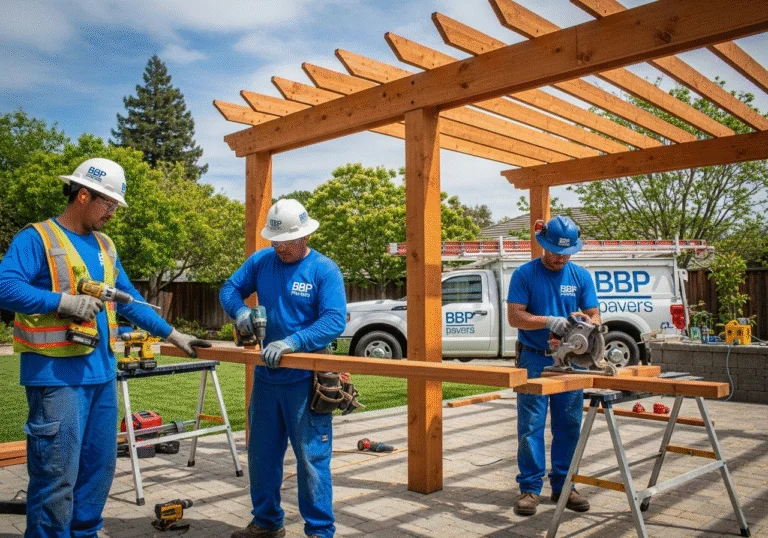How to Install Pavers: A Complete Guide

Understanding how to install pavers is essential to avoid incorrect paving. Pavers come in various shapes, but their installation is straightforward.
Read on for our comprehensive guide on installing pavers step by step and their maintenance!
Choosing the Right Paver
There’s a suitable paver for every type of paving job you want to do. They come in various shapes and colors to meet your project’s needs.
Types of Pavers
There are various types of pavers available in the market. Here’s a brief on each:
- Concrete Pavers: Concrete pavers are popular because of their durability and versatility. They come in a wide range of colors and textures, allowing for various paving styles.
- Natural Stone Pavers: Natural stone pavers, such as granite, basalt, or sandstone, offer a sophisticated and elegant look. They are known for their durability and wear resistance, adding a natural touch to the setting.
- Permeable Pavers: Designed specifically to aid water drainage, permeable pavers allow rainwater to seep into the ground efficiently. They are perfect for areas where rainwater management is a concern.
- Clay Pavers: Clay pavers are renowned for their classic and elegant appearance. They come in various colors and sizes, adding timeless charm to any paved area.
- Eco-friendly Pavers: Made from recycled materials like plastic or rubber, these sustainable options are environmentally friendly, offering an excellent blend of durability and aesthetics.
Essential Tools and Materials
For a correct paver installation, you’ll need certain tools and materials.
Essential Tools
- Tape measures
- Stakes
- Shovels and hoes
- Mason’s trowel
- Rubber mallets
- Wheelbarrow for sand and block transportation
- Vibratory plates
- Wooden guides and/or metal tubes
- Metal rulers and/or straightened wooden boards for leveling sand
- Pencils
- Nylon strings
- Brooms
Required Materials
- Fine sand
- Medium sand
- Gravel
- Concrete for internal containment
- Paving concrete
Installation Step by Step
Here are the steps to follow for correct paver installation:
Ground Preparation
Proper ground preparation is crucial for the correct installation of pavers.
Preparation is essential; therefore, it’s important to check the quality of the soil and level it.
Maintaining the site helps ensure everything is level for the addition of layers of sand or stone dust. These layers assist in ensuring that the pavers are set evenly.
Setting the Base
To build the base, it will be necessary to use a machine designed for setting pavers to compact the soil.
Afterwards, run the machine over the surface to be compacted, ensuring the final setting of each piece, making the pavers firm and durable.
Applying Sand
The layer of sand or stone dust beneath is essential to provide added strength to the material once it’s finished. It’s recommended to have a thickness between 1.6 inches and 3.2 inches. If necessary, use iron pipes ranging from 1.2 inches to 2 inches for support.
Placing the Pavers
The setting of pavers should be done in a way that the pieces are parallel to the curb or the terrain’s edge.
The pieces can be fitted in whatever manner the professional prefers, but always side by side, ensuring no gaps are left, so water doesn’t damage the pavers.
Protection and Finishing
To protect and finish, use sand. It should be applied over the entire surface of the pavers after they have been set. It will act as grout and help with the durability of the piece fixation.
To clean the floor, it’s necessary to sweep and wash to remove the dirt and any remaining sand left after setting.
Design Considerations
When planning your project, decide on the paving pattern so that during installation, the desired pattern is achieved.
Paving Patterns
With the detailed project in hand, the layout helps design the paver installation and also anticipate possible manholes, posts, and trees in the way. It serves as a guide to know which models and colors to follow during the installation of the pieces.
The most common block styles are rectangular and the so-called “little bricks”, being the most well-known and used. The most common layout patterns are: herringbone, checkerboard, and fishbone.
Safety and Precautions
To ensure safety at the paver installation site, the first step is to use signs. It’s essential to isolate the area with tape, cones, sawhorses, etc.
Isolating is a precaution to prevent accidents with people passing by and to ensure the ongoing work is not compromised.
Safety Equipment
All site workers should use Personal Protective Equipment (PPE), such as:
- Boots
- Helmets
- Goggles
- Ear protectors
- Knee pads
- Gloves
Maintenance and Care
To keep the paver well-maintained and prevent accidents, it’s essential to stay up-to-date with maintenance. Since pavers are easy to handle, ensuring they are always in good condition requires minimal effort.
Keeping Your Paving Immaculate
For maintenance, it’s important to check for any broken pieces and other details, clean the paving, sweep and wash to remove all dirt, and if necessary, trim the grass and remove weeds.
Replacing the sand in the joints, which helps keep the pavers connected and firm, is essential to ensure they don’t come loose.
Cost and Value
Using pavers offers numerous benefits, such as sustainability and ease of use. They also offer financial advantages:
Return on Investment
Using pavers offers greater cost savings due to their increased permeability and durability, which reduces maintenance expenses.
They are very practical in their fit and in the use of installation materials. For maintenance, you can simply remove and re-fit the pieces, ensuring their original layout and firmness remain.
As previously mentioned, pavers have high permeability, allowing rainwater to drain more easily since it is absorbed by the sand and crushed stone layer beneath the pieces.
Furthermore, the paver flooring is very durable, accommodating both pedestrian traffic and light to heavy vehicle traffic, withstanding 4 times the load of traditional concrete flooring.
Conclusion
As we’ve seen, paver flooring is a technological and sustainable solution, as well as being more cost-effective. When installed correctly, it becomes a modern and highly durable pavement. Therefore, to ensure a quality installation, hire skilled professionals for your project.






